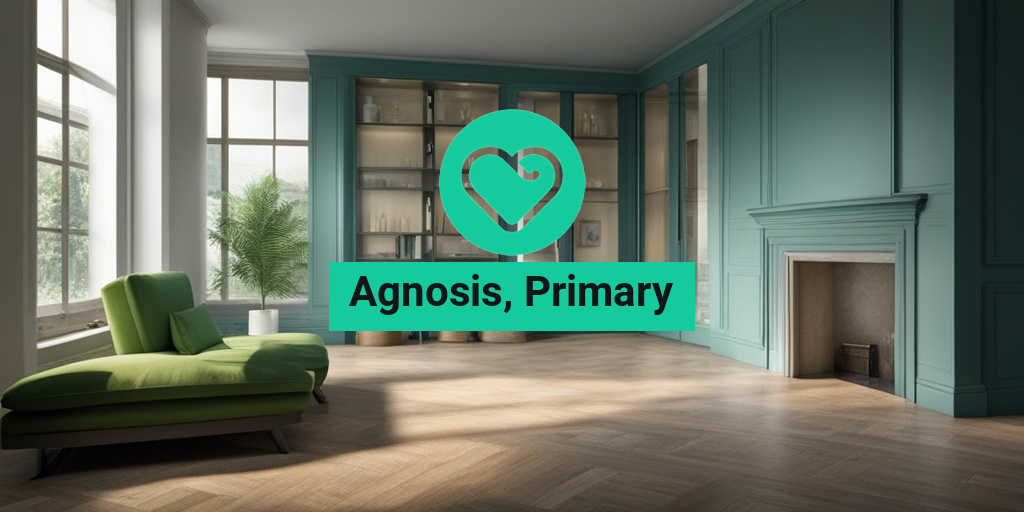What Is Primary Agnosia?
Have you ever heard of the term “agnosia”? It’s a fascinating yet complex topic in the realm of neuroscience and psychology. In this article, we’ll delve into the world of primary agnosia, exploring its definition, causes, symptoms, and more. So, let’s get started! 🧠
Primary Agnosia Definition
Primary agnosia is a rare and intriguing neurological disorder characterized by the inability to recognize and identify objects, people, or sounds, despite having normal sensory function. This means that individuals with primary agnosia can see, hear, or feel things normally, but their brain struggles to process and interpret the information.
Imagine being unable to recognize your loved ones, familiar objects, or even your own reflection in the mirror. This is the reality for people living with primary agnosia. The condition can be quite debilitating, affecting daily life and social interactions.
Primary agnosia is often referred to as “perceptual agnosia” or “appereceptive agnosia.” It’s essential to note that this condition is different from other types of agnosia, such as associative agnosia, which involves difficulties with object recognition due to damage to the brain’s associative memory.
Now that we’ve covered the basics, let’s dive deeper into the causes and symptoms of primary agnosia.
Causes of Primary Agnosia
The exact causes of primary agnosia are still not fully understood, but research suggests that it can result from various factors, including:
- Head trauma or brain injury
- Stroke or cerebral vasculature disorders
- Infections, such as encephalitis or meningitis
- Neurodegenerative diseases, like Alzheimer’s or Parkinson’s
- Genetic mutations or congenital conditions
In some cases, primary agnosia can be a symptom of a larger neurological disorder, such as prosopagnosia (face blindness) or simultanagnosia (difficulty perceiving multiple objects simultaneously).
Symptoms of Primary Agnosia
The symptoms of primary agnosia can vary widely depending on the individual and the severity of the condition. Some common symptoms include:
- Difficulty recognizing objects, people, or sounds
- Struggling to identify shapes, colors, or patterns
- Problems with spatial awareness and navigation
- Difficulty understanding spoken language or written text
- Struggling to perform daily tasks, such as dressing or grooming
If you or a loved one is experiencing these symptoms, it’s essential to consult with a healthcare professional for an accurate diagnosis and appropriate treatment.
While primary agnosia can be a challenging condition, there is hope for improvement with the right treatment and support. In the next section, we’ll explore the diagnosis and management of primary agnosia.
Stay tuned for more information on this fascinating topic! 🤔
(Note: The article will be continued in the next response. Please let me know if you need any changes or modifications.)

Types of Primary Agnosia
Primary agnosia is a rare and complex neurological disorder that affects an individual’s ability to recognize and identify objects, people, or sounds. There are several types of primary agnosia, each with distinct characteristics and effects on daily life. Let’s dive into the different types of primary agnosia:
Visual Agnosia
Visual agnosia, also known as visual object agnosia, is the most common type of primary agnosia. People with visual agnosia have difficulty recognizing objects, even though their vision is normal. They may struggle to identify everyday objects, such as a chair or a book, and may have trouble recognizing faces, including those of family members and friends.
Auditory Agnosia
Auditory agnosia, also known as pure word deafness, is a type of primary agnosia that affects an individual’s ability to recognize and understand sounds. People with auditory agnosia may have difficulty recognizing voices, music, or other sounds, even though their hearing is normal.
Tactile Agnosia
Tactile agnosia, also known as astereognosis, is a type of primary agnosia that affects an individual’s ability to recognize objects through touch. People with tactile agnosia may have difficulty identifying objects by feeling their shape, size, or texture.
Prosopagnosia
Prosopagnosia, also known as face blindness, is a type of primary agnosia that affects an individual’s ability to recognize faces. People with prosopagnosia may have difficulty recognizing faces, even those of family members and friends, and may struggle to remember faces they’ve seen before.
Primary Agnosia Symptoms
Primary agnosia symptoms can vary depending on the type of agnosia and the individual affected. However, some common symptoms of primary agnosia include:
Difficulty Recognizing Objects
People with primary agnosia may have difficulty recognizing objects, even though they may have seen them before. This can make everyday tasks, such as cooking or cleaning, challenging.
Difficulty Recognizing Faces
Individuals with primary agnosia may have difficulty recognizing faces, including those of family members and friends. This can lead to feelings of embarrassment or anxiety in social situations.
Difficulty Understanding Sounds
People with auditory agnosia may have difficulty understanding sounds, including voices, music, or other noises. This can make communication and social interactions challenging.
Difficulty with Spatial Awareness
Individuals with primary agnosia may have difficulty with spatial awareness, which can affect their ability to navigate through spaces or understand the relationships between objects.
It’s essential to note that primary agnosia is a complex condition, and each individual’s experience may vary. If you or a loved one is experiencing symptoms of primary agnosia, it’s crucial to consult with a healthcare professional for proper diagnosis and treatment. 🏥

Primary Agnosia Causes and Risk Factors
Primary agnosia is a rare and complex neurological disorder that affects an individual’s ability to recognize and identify objects, people, or sounds. While the exact causes of primary agnosia are still not fully understood, research has identified several risk factors and potential underlying mechanisms that contribute to its development.
Genetic Factors
Studies suggest that primary agnosia may have a strong genetic component. Individuals with a family history of agnosia or other neurological disorders may be more likely to develop the condition. Research has identified several genes that may be associated with primary agnosia, including those involved in brain development and function.
Brain Injury or Damage
Traumatic brain injury, stroke, or other forms of brain damage can increase the risk of developing primary agnosia. This is because damage to specific brain regions, such as the temporal or parietal lobes, can disrupt normal processing and recognition of sensory information.
Infections and Inflammation
Certain infections, such as encephalitis or meningitis, can cause inflammation in the brain, leading to damage and disruption of normal brain function. This can increase the risk of developing primary agnosia.
Neurodegenerative Disorders
Conditions such as Alzheimer’s disease, Parkinson’s disease, and other neurodegenerative disorders can increase the risk of developing primary agnosia. These conditions can cause progressive damage to brain cells and disrupt normal brain function.
Other Risk Factors
Other potential risk factors for primary agnosia include:
- Aging: Primary agnosia is more common in older adults, suggesting that age-related changes in the brain may contribute to its development.
- Environmental toxins: Exposure to certain environmental toxins, such as heavy metals, may increase the risk of developing primary agnosia.
- Nutritional deficiencies: Deficiencies in certain nutrients, such as vitamin B12, may contribute to the development of primary agnosia.
It’s essential to note that primary agnosia is a complex condition, and the exact causes and risk factors may vary from person to person. Further research is needed to fully understand the underlying mechanisms of this condition.
Primary Agnosia Diagnosis and Testing
Diagnosing primary agnosia can be challenging, as it requires a comprehensive evaluation of an individual’s cognitive, sensory, and motor functions. A team of healthcare professionals, including neurologists, psychologists, and occupational therapists, may be involved in the diagnostic process.
Clinical Evaluation
The diagnostic process typically begins with a thorough clinical evaluation, including:
- Medical history: A review of the individual’s medical history to identify any underlying conditions that may be contributing to their symptoms.
- Neurological examination: A physical examination to assess cognitive, sensory, and motor functions.
- Behavioral observations: Observations of the individual’s behavior and interactions to identify any patterns or abnormalities.
Neuropsychological Testing
Neuropsychological tests may be used to assess cognitive functions, such as:
- Memory: Tests to evaluate short-term and long-term memory, including recall and recognition.
- Attention: Tests to evaluate attention, concentration, and processing speed.
- Perception: Tests to evaluate visual, auditory, and tactile perception.
Imaging Studies
Imaging studies, such as MRI or CT scans, may be used to rule out other conditions that may be causing symptoms similar to primary agnosia. These studies can help identify any structural abnormalities in the brain.
Functional Assessments
Functional assessments, such as occupational therapy evaluations, may be used to assess daily living skills and identify areas of difficulty.
A comprehensive diagnostic evaluation is essential for accurately diagnosing primary agnosia and developing an effective treatment plan. 💡

Primary Agnosia Treatment and Management
Primary agnosia is a rare and complex neurological disorder that affects an individual’s ability to recognize and identify objects, people, or sounds. While there is no cure for primary agnosia, various treatment and management strategies can help alleviate its symptoms and improve the quality of life for those affected.
Rehabilitation and Therapy
Occupational therapy plays a crucial role in helping individuals with primary agnosia adapt to their condition. Occupational therapists work with patients to develop strategies for daily living, such as using assistive devices, compensatory techniques, and environmental modifications to enhance independence.
Speech therapy is also essential in addressing communication difficulties associated with primary agnosia. Speech therapists help patients improve their language skills, including reading, writing, and speaking, to facilitate better communication.
Cognitive Training and Compensatory Strategies
Cognitive training programs can help individuals with primary agnosia improve their cognitive functions, such as attention, memory, and problem-solving. These programs often involve computer-based exercises, puzzles, and games designed to stimulate the brain and promote neural plasticity.
In addition to cognitive training, compensatory strategies can be employed to bypass damaged brain areas and utilize intact cognitive functions. For example, individuals with primary agnosia may use visual aids, such as pictures or diagrams, to aid in object recognition or rely on auditory cues, like sounds or music, to facilitate memory recall.
Medications and Surgery
In some cases, medications may be prescribed to manage associated symptoms, such as anxiety, depression, or seizures. However, there is no medication that can directly treat primary agnosia.
Surgery may be considered in rare instances where primary agnosia is caused by a brain tumor or other structural abnormalities. However, surgical interventions are typically reserved for cases where the underlying cause can be directly addressed, and the potential benefits outweigh the risks.
Living with Primary Agnosia
Living with primary agnosia can be challenging, but with the right support, accommodations, and strategies, individuals can adapt and thrive.
Building a Support Network
Surrounding yourself with a supportive network of family, friends, and healthcare professionals is crucial in coping with primary agnosia. This network can provide emotional support, assist with daily tasks, and help individuals navigate the complexities of the condition.
Adapting to Daily Life
Individuals with primary agnosia often need to make significant adjustments to their daily routines. This may involve using assistive technology, such as text-to-speech software or magnifying glasses, to facilitate daily tasks.
Additionally, individuals may need to develop new ways of completing tasks, such as using step-by-step instructions or breaking down complex tasks into simpler, more manageable steps.
Embracing Creativity and Self-Expression
Primary agnosia can affect an individual’s sense of identity and self-expression. Engaging in creative activities, such as art, music, or writing, can help individuals express themselves and maintain a sense of purpose and fulfillment.
By embracing their unique strengths and abilities, individuals with primary agnosia can find ways to thrive and live a fulfilling life despite their condition 🌟.

Frequently Asked Questions about Agnosia, Primary
What is Agnosia, Primary?
Agnosia, Primary is a rare neurological disorder characterized by the inability to recognize and identify objects, people, or sounds, despite having normal sensory function.
What are the causes of Agnosia, Primary?
The exact causes of Agnosia, Primary are still unknown, but research suggests that it may be related to genetic mutations, brain damage, or developmental abnormalities.
What are the symptoms of Agnosia, Primary?
The symptoms of Agnosia, Primary can vary depending on the individual, but common symptoms include difficulty recognizing objects, people, or sounds, even with normal sensory function. In some cases, individuals may experience difficulty with language processing, memory, or spatial awareness.
How is Agnosia, Primary diagnosed?
Agnosia, Primary is typically diagnosed through a combination of neurological exams, cognitive tests, and imaging studies such as MRI or CT scans.
Is there a treatment for Agnosia, Primary?
There is no cure for Agnosia, Primary, but various therapies and strategies can help manage the symptoms. These may include cognitive training, speech therapy, occupational therapy, and behavioral therapy.
Can Agnosia, Primary be inherited?
Research suggests that Agnosia, Primary may have a genetic component, but more studies are needed to fully understand the role of inheritance in this disorder.
Is Agnosia, Primary related to other neurological disorders?
Agnosia, Primary can occur in conjunction with other neurological disorders, such as autism spectrum disorder, Alzheimer’s disease, or stroke. However, it is a distinct condition with unique characteristics.
Can people with Agnosia, Primary lead normal lives?
With proper therapy and support, individuals with Agnosia, Primary can adapt to their condition and lead fulfilling lives. However, it may require significant adjustments and accommodations.
Where can I find more information about Agnosia, Primary?
There are several organizations and resources available for individuals with Agnosia, Primary, including the National Institute of Neurological Disorders and Stroke (NINDS) and the Agnosia Foundation. 💡




